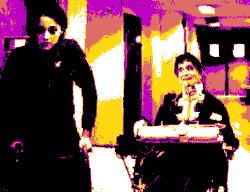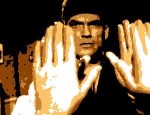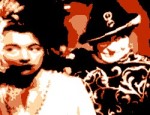Film Review
In
Du bleu jusqu'en Amérique, her first and (so far) only film
for the cinema, director Sarah Lévy makes a bold attempt to take us
into the world of the mentally impaired and physically handicapped but fails
to engage sufficiently with her subject to make this incredibly risky exercise
worthwhile. To be fair, Lévy deserves some credit for her efforts
to get across the mood of hopelessness that permeates every inch of an under-resourced
state hospital, and also the desperation felt by someone who feels he may
be crippled for life, but she lets herself down badly by failing to make
any of her characters convincing and sympathetic. We see them just
as any outsider would, unsightly misfits behaving in ways that we would expect
them to, not as human beings trying to forge meaningful lives for themselves
out of their misfortune.
It may not have been intentional, but Lévy's comedic slant carries
a slightly off-putting note of derision which badly works against the human
drama on display. As a consequence, we feel ourselves constantly distanced
from the characters, unable to emphasise with them or even to regard them
as anything other than crude misshapen semblances of the human form.
Du bleu jusqu'en Amérique has some impressive acting talent
at its disposal (including Marion Cotillard, who won the Best Actress Oscar
in 2008 for her portrayal of Edith Piaf in
La Môme) but this is largely wasted
on a film that is so lacking in genuine human feeling and depth. All
that the film demonstrates is that disability is hardly a suitable subject
for comedy. Jean-Pierre Sinapi's
Nationale
7 (2000) covers similar ground but far more successfully, because
it succeeds where Lévy's film fails, in humanising all of the disabled
characters it portrays.
© James Travers 2002
The above content is owned by frenchfilms.org and must not be copied.
Film Synopsis
After sustaining severe injuries in a road accident, an adolescent named
Camille begins a course of physiotherapy in a strictly run rehabilitation
centre run by Professor Helpos. Although he is presently confined to
a wheelchair, the unfortunate youngster is determined to walk again, if only
to hasten his departure from this grim, ghetto-like institution. He
soon falls in with a group of wild misfits who refer to themselves as 'the
wreckers'. These rebellious individuals insist on living by their own
rules, ignoring those that are foisted upon them by Helpos and his unfriendly
staff. With his new friends, Camille soon regains his zest for living,
first through his friendship with Hamid and his gang of drop-outs, and then
through an unexpected love affair with an attractive girl named Solange...
.
© James Travers
The above content is owned by frenchfilms.org and must not be copied.



